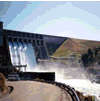
Hydromodification (i.e., stream channel modification) is the alteration of stream and river channels resulting from activities such as:
Hydromodification can result in adverse impacts on the physical and chemical characteristics of surface waters, on groundwater levels, and on aquatic and riparian habitat. Hydromodification effectively reduces stream base-flow (i.e., groundwater flow into streams) and increases overland or storm-flow, which causes reduced groundwater recharge and increased peak runoff discharge rates into streams and rivers. Hydromodification may result in stream channel instability and streambank or shoreline erosion, which in turn modifies the stream’s natural water temperatures and flow regime.
Descriptions of this land use category and its Management Measures are adapted from California’s NPS Encyclopedia. More Info

Evaluate, plan, design, operate, and maintain channelizations and channel modifications to minimize adverse impacts on the physical and chemical characteristics of surface waters, and on aquatic and riparian habitat. More Info
Minimize erosion and sedimentation during construction, and minimize the release of construction chemicals (including herbicides, pesticides, and nutrients). Implement an erosion and sediment control plan, and a program to manage construction activities that limits the application and migration of toxic chemicals. More Info


Manage the operation and release of surface water from dams, and manage maintenance activities, to meet water quality and aquatic habitat objectives. Limit the application and migration of chemicals (including herbicides, pesticides, and nutrients). More Info
Remove dams or levees which are unsafe, unwanted, and/or obsolete, considering alternatives to minimize temporary sedimentation to adjacent waterbodies, increased downstream flooding, and release of contaminated sediment. More Info


Protect streambanks to minimize erosion, and stabilize eroding streambanks and shorelines using indirect or vegetative methods instead of structural methods. More Info
Maintain or restore hydrologic stream flows that promote stream channel equilibrium and are appropriate for the watershed. Use modeling to determine the effects of stream channel and riparian management activities on water temperatures and flows. More Info


Implement educational programs to improve understanding of watersheds and increase the use of appropriate hydromodification management measures and practices. Promote projects that retain or reestablish natural hydrologic functions and maintain stream equilibrium. More Info